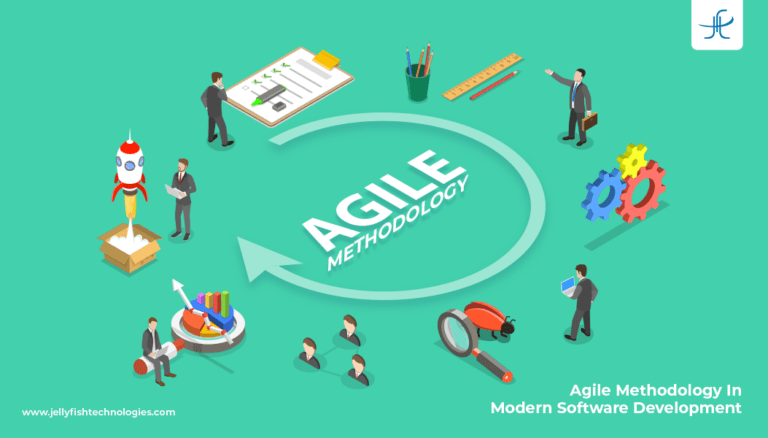The popularity of the agile method has grown extensively over the years. As of now, every IT company uses the agile software development methodology to develop and deliver high-quality products/software to the market.
Let’s take a look at what agile software development is, its types, and workflow.
What Is an Agile Methodology and How Does It Work?
Agile software development is primarily a development process that consists of various approaches and methodologies for creating software from scratch. This procedure is set up to deliver items in pieces rather than as a whole.
It allows developers to test the product at each stage and make changes until the full product is ready.
Agile Software Development Workflow
There are six steps in the agile workflow cycle:
1. Concept: It is the first and most important step of this method. It investigates key aspects of the project, such as the software’s business potential, the project’s timeline, and budget, among others. This step helps in prioritizing the tasks and costs for the whole project.
2. Inception: In this step, different teams and their responsibilities are distributed along with deadlines. After this, the clients and stakeholders are asked to put down the project’s requirements.
3. Construction: Teams begin to develop the software with the help of continuous input in each sprint. This step of construction is responsible for the entire workflow and functioning of the software.
4. Release: The final QA testing of the finished product is called release. Everything regarding the software is reviewed in this step.
5. Production: The production stage is responsible for the software’s maintenance. This step is a never-ending procedure that aims to improve the user’s experience and the software’s quality.
6. Retirement: When a piece of software retires, it is usually replaced with a new piece. This step is responsible for shutting down all of the existing software’s operations related to the retired piece and updating them according to the new piece.
Types of Agile Methodologies
I. Scrum:
Scrum is one of the most popular agile software development strategies. This process delivers the project in parts and runs several sprints and QA tests to improve the software’s performance and development.
It also conducts regular routine meetings to discuss the sprint’s progress and the project is concluded with a demo meeting in which the client/product owner is shown how the developed software will function.
II. Inception:
Crystal is the most effective approach to interaction. This method emphasizes the project’s unique strengths and features through its development process, policies, and practices.
There are three different types of crystal postures:
- Crystal orange
- Crystal yellow
- Crystal clear
Each of them has its own set of behaviors, priorities, and teamwork.
III. Kanban:
The Kanban framework is guided by two principles-
- Visualization of the workflow
- Improving the flow of work by limiting the amount of work in progress
Kanban enables specific business divisions, such as human resources and marketing to operate with transparency and effective communication for all team tasks. It emphasizes team members to stay informed about the progress of development and can monitor the status of a project at any moment.
This method allows teams to take an active role in the process and work more efficiently and collaboratively on agile software development.
IV. Extreme Programming:
Extreme programming is a rigorous approach that ensures a smooth workflow and timely delivery of the product. The method highly values communication, simplicity, feedback, and customer satisfaction. It also encourages teams to be productive and efficient.
Furthermore, it necessitates ongoing planning, input, and testing and guarantees the delivery of high-quality software.
V. Dynamic System Development Method (DSDM):
DSDM has eight principles, each of which is vital and useful in agile software development.
These principles are as follows:
- Focus on the business need
- Deliver on time
- Collaborate
- Never compromise quality
- Build incrementally from firm foundations
- Develop iteratively
- Communicate continuously and clearly
- Demonstrate control
VI. Agile For the Next Generation:
Agile software development approaches are employed by a wide range of IT companies from large to small scale. Adopting an agile methodology framework necessitates a thorough study of all the frameworks for developers to select the best one for their company or project.
In large modern enterprises, several agile frameworks are used in different teams and projects to increase understanding, communication, and teamwork during software development.
With the development process becoming more complex and sophisticated, adopting agile methodologies can assist organizations in successfully bringing their products to reality without requiring excessive execution and planning.
Conclusion
The amount of time spent developing a product while mapping how a task can be completed has a significant impact on the final outcome. Therefore, organizations must choose the best software development solution according to their customer or client needs.
Looking to partner with a software development organization?
You’ve come to the right place.
Jellyfish Technologies has a highly experienced team of developers who are well-versed in agile methodologies and can turn your application vision to life.


